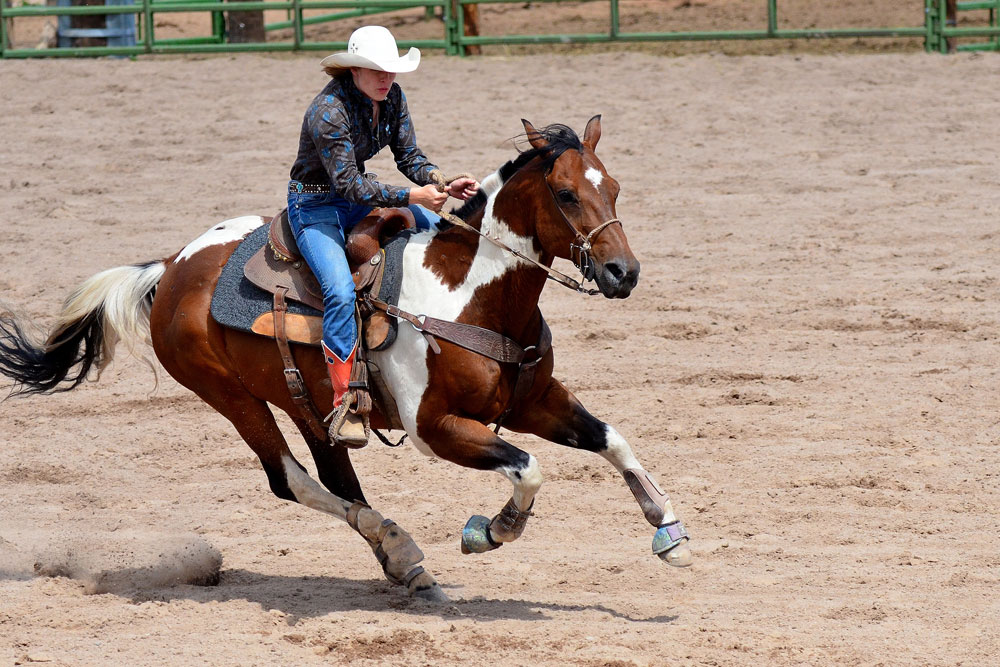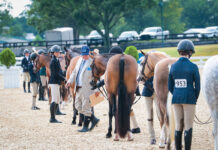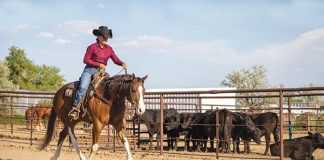Practice makes perfect, right? Yes, but if your speed event practice consists of running a pattern over and over again, all that hard work could backfire. Horses that run a barrel or pole pattern for practice begin to think they know the pattern better than you do. What’s worse, the excitement and stress of running the pattern repeatedly makes your horse think one thing when he sees a barrel or pole: run. The result is a horse that bolts through his turns without listening to the rider; barrels and poles are tipped over, turns are blown and things quickly spiral out of control. In addition, repetition can also make a horse sour on the patterns or bored. But the right kind of practice does make perfect. After years of coaching riders, attending clinics and training horses, Linda Stenerson, a longtime national barrel racing competitor herself, knows the tried and true schooling strategies to help a horse stay focused and challenged. Here’s her advice to make the most of your practice.
Think Turn, Not Run
A horse that runs through his turns is the number one problem Linda sees in competition—a problem exacerbated by hurrying straight through the pattern in practice. “I feel practice is a time to correct problems like running through a turn,” Linda says. “Slow down practice and allow your horse to think about what you are trying to teach him.”
To make a tight, fast and accurate turn, your horse needs to rate his speed before a barrel or pole. Linda suggests imagining your horse is an accordion: On the straightaways, he’s stretched out for full speed, but around the turns he must “accordion up”—pull his body together and bring his hind legs underneath himself so that he takes the shortest way around the obstacle with maximum power. “My motto for years has been ‘rate, sit down, come around, drive,’ ” Linda says. “Rate comes first—and drive, referring to run, comes after the turn and not in it.”
To improve your horse’s competition runs, Linda recommends the following exercises, which will bring your horse’s attention back to you and improve his rating, turning and overall performance.
#1 Practice Stopping
“Regardless of the speed you approach the barrel [or first and last pole], by reinforcing the rate, you teach your horse when to prepare for the turn by slowing down,” Linda says. One exercise she uses for teaching a horse when to prepare for the turn involves stopping him at the point where you want him to rate.
Approach the barrels at the walk, trot, lope or gallop, then stop your horse where he should rate. (Note: whether you compete using the straight pole pattern or Quarter Horse poles, Linda recommends always practicing with the Quarter Horse poles pattern). Pair the spot where you want your horse to rate and the “whoa” command, and ask your horse to stand until he relaxes a bit, then complete your turn at the walk or trot. After completing the turn, pick up your original speed and continue to your next turn, where you’ll stop once again at the point where you want your horse to rate (riders practicing poles will rate at the first and last pole, where a complete turn is required; barrel riders will rate and stop before each barrel).
#2 Trot the Turn
Another strategy Linda recommends to help your horse rate and think about his turns involves trotting around the barrels (or first and last poles). Lope or gallop the pattern, but break into a trot where your horse should rate. Trot through the turn, picking up speed only after the turn is completed.
Next, try completing the entire pattern at an extended trot, but bring your horse into a collected trot where you’d want him to rate. Maintain the collected trot through the turn (think of the accordion image), then return to the extended trot between obstacles. As Linda points out, this exercise will help “remind your horse to be in control for the turns.” Trotting the pattern is also an excellent way to condition your horse.
#3 Pleasure Barrels
To teach your horse to listen to you when he sees a barrel, practice riding an alternative barrel pattern that Linda calls “pleasure barrels.” “The three barrel pattern is so boring to your horse that after a while he begins to try his own ideas on how to turn barrels,” Linda says. “By changing his practice time, it allows him to relax and listen to the things you’re teaching him about approach and rate.”
For this exercise, pole benders can use poles set in a cloverleaf barrel pattern and complete the exercise as follows to improve their turns. With the pleasure barrel pattern, you’ll ride a triangle around the outside of the cloverleaf barrel pattern, circling each barrel four times. Start loping on your right lead, headed to the right. Circle the top (third) barrel, making a medium-size circle around it—staying about 20 feet from the barrel and keeping it in the center of your circle. Repeat the medium-size circle a second time, then complete two small circles (about the size you’d use running the pattern). Lope a straight line to the outside of the next (first/right) barrel and repeat the two medium-size and two small-size circles to the right. Ride to the second barrel and again make four right turns, then ride on to the top (third) barrel. Complete your turns at the third barrel. If you want to mix things up once you’ve completed your second round of turns at the third barrel, continue to the first barrel, make your four turns, then run the proper cloverleaf pattern, moving from the first barrel to the second and completing the pattern as you normally would. Lope the pleasure barrel pattern to the left as well.
#4 Telescope
To challenge your horse, Linda suggests riding a telescope pattern. “Telescope barrels are a good way to change your practice. To me it’s all about giving your horse challenges during practice time while still teaching him the proper placement for his feet in a turn and always rating to prepare for the turn,” Linda says. “Telescope barrels are also a challenge for the rider, who must correctly cue the horse for each turn.”
For the telescope pattern, you’ll need 8 – 10 cones, poles or barrels. Set them parallel to each other. The first two will be 45 feet apart and the final two 25 feet apart—thus forming the shape of a telescope. First, try trotting the pattern, making a right turn around the first obstacle and a left turn around the obstacle directly across from it, moving your way through the telescope from the wide end to the short end. Next, try the pattern at the lope. Just as in barrels or poles, your horse will have to switch leads with each turn. Once you’ve mastered the exercise, mix it up. For example, turn right around the first obstacle then left around the second one on the opposite side. You can skip around to keep your horse on his toes, listening to your cue to turn rather than his own memory of the pattern.
…and Don’t Forget
When you practice, Linda warns never to pass near a barrel if you are not planning on turning it. “You’re always teaching your horse something,” Linda says. “Just make sure it’s something you want to teach him.” By running close by a barrel and not turning it, you’re teaching the horse that’s sometimes OK to do. The same goes for bad turns: If your horse makes any of his turns too wide or too tight, make the turn again, and don’t move on until it’s right. If your horse drops his shoulder into the barrel at a particular point in your turn, circle your horse there beside the barrel (in the same direction you’re turning the barrel), then complete the turn.
To emphasize completing turns and staying focused when practicing at home, Linda asks her horses to complete the final turn around the third barrel and then return to the rail rather than running back to the starting point (see dotted line on cloverleaf diagram). However, she recommends starting and finishing each workout by completing the pattern in the correct format so that the final memory your horse goes home with is the correct pattern.
There are countless ways to practice your horse for speed events. The important thing is to avoid burnout or tension caused by constantly running the same patterns. Keep your horse’s mind and body sharp, and his runs will be, too.
Further Reading
Build Speed for Better Barrel Racing
Seven Habits of Highly Effective Barrel Racing
Micaela Myers is a horse owner and freelance writer based in California.
This article originally appeared in the April 2004 issue of Horse
Illustrated. Click here to subscribe.








Great article with fabulous tipS
thank you for all the tips on barrel racing its helping me so much thanks again Linda
Good article
Thanks
A lot of people don’t understand not to over-do the pattern. Walk and trot the pattern but try only running it twice at the most. If they run it great the first time, LEAVE IT ALONE UNTIL YOUR NEXT COMP. Great read! Thanks!
Excellent article.
Great tip! Especially liked the idea of pleasure barrels.